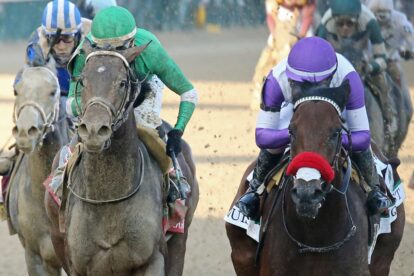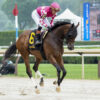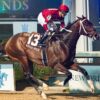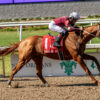First off, Pimlico Race Course has been known as “an inside speed favoring track with tighter turns.”
Not to debunk these statements, but if you follow horse racing, you’ve probably heard these phrases at least a dozen times this week leading up to the 141st Preakness Stakes to be run at 1 & 3/16 miles this Saturday, May 21, at 6:45 p.m. (EDT) at Pimlico in Baltimore, Maryland.
The perception of the tight turns are actually more of a result of the decreased angle of banking on the turns, which helps to favor inside horses and adds to the aura of the speed favoring nature of Pimlico. These factors need to be incorporated into handicapping the Preakness, but one must first handicap the pace of the race and not be overly swayed by the overarching theories of the track bias.
With a quick glance at the Preakness past performances, it doesn’t take a lot of analysis to determine that the pace should be fast as an ensemble of speedy “new shooters” (another overused Preakness term!) try to take down the Kentucky Derby victor Nyquist, as he embarks on his attempt to capture the second jewel of a possible Triple Crown.
In this “Preakness Pace Profile,” we’ll go beyond these simple assertions above and dig deeper into historical data to determine how the race may be run and the best approach to try to structure wagers based on these trends.
We’ll start off by diving into the top four key trends from the past 5 Preakness Stakes:
Trend #1: Speed Has Won
Even though it may be somewhat irritating to continue to hear “speed favoring” theories when discussing the Preakness, the winners in the last 5 years support the notion that a horse needs to be nearer to the lead to win the “Run for the Black Eyed Susans.” The table below shows the winners of the last 5 years of the Preakness and where the winner sat at the ½ mile point in the race:

- Oxbow and American Pharoah in 2013 & 2015, respectively, went gate-to-wire leading the whole race to win the Preakness.
- Shackleford in 2011 pressed in second only a ½ length off the lead to win.
- California Chrome sat in 3rd only 2 lengths off the pace in 2014 before pulling away easily in the stretch to win.
- I’ll Have Another in 2012 was the farthest from the lead early in the race, but was only 3½ lengths back in 4th before taking over in the stretch.
Additionally, looking at the Brisnet run styles of the winners, each winner demonstrated either “Early” (E) or “Early / Presser” (E/P) characteristics coming into the race. For those not familiar with the Brisnet Run Style Definitions, please see the summary below:
- The run style of each horse is either:
- E = Early (vies for early lead, need-the-lead types)
- E/P = Early/Presser (may run on front-end, can reasonably be expected to lay behind a pacesetter)
- P = Presser (runs in mid-pack, may run closer to the pace, but rarely challenges for the lead early)
- S = Sustained or Closer (runs in back-of-the-pack early before making a late move)
- The number next to the run style represents the early speed points. The numbers range from 0-8 and measure the Early Speed of the horse based on its running position and beaten lengths at the first call of recent races. The higher the number, the more early speed a horse has shown in recent races.
Based on these trends from the most recent 5 years, it seems almost a forgone conclusion that a horse with early speed will win the 2016 Preakness, but five data points is a small sample to use to make predictions.
WHAT TREND #1 MEANS FOR 2016 PREAKNESS?
Correlating the trend above to this year’s Preakness is the next step to determine a winner. Looking at the horses’ run styles in this year’s Preakness, you will see a ton of speed signed on (see table below with Brisnet running styles for each horse sorted by post position):

It should be immediately noted that 7 of the 11 entered horses have either “E” (Early) or “E/P” (Early / Presser) as their run style. With the majority of the horses wanting to naturally show early speed, there is every reason to believe that a few of them will “hook up” on the front end and press each other into fast fractions.
Using the trend from the past 5 years above, it would be realistic for one of these seven horses to win the 2016 Preakness, since they all show the ability to be nearer to the pace.
From the relatively inside #3 post position, Nyquist (E/P6) is just too good and has too much front-end speed to let the outside speed horses get too far in front of him. There is a possibility that jockey Mario Gutierrez tries to take Nyquist gate-to-wire and avoid getting him caught behind horses or in traffic, especially with rain in the Preakness day forecast. Gutierrez may put Nyquist on the lead to avoid being behind horses and taking mud / slop kick back. More likely, Gutierrez will find a nice spot to flank outside of one or two of the “E” horses and stalk from there.
One would think that a likely pace setter may be the maiden Laoban (E6) since he set hot paces in both of his last two Stakes races (Bluegrass & Gotham), but trainer Guillot is taking the blinkers off him for this big race, so it is possible that he will sit off the pace this time starting from an outside post #8.
Abiding Star (E8) has been leading at the first call in his last 8 races, so he is a likely pace setter, but his early Brisnet pace figures show that he may not have enough speed to capture the lead in a classier group than he is accustomed to. Also starting from the outside #9 post, he will have to clear five early speed / presser types to his inside to get the lead.
Uncle Lino (E7) went gate-to-wire in his last race (California Chrome Stakes) showing early speed and the ability to hold on, actually accelerating late (using his Brisnet late pace figures). He was able to sit second in his previous two races, but from his inside #2 post jockey Fernando Perez may need to send him early to be on the pace in the Preakness.
Awesome Speed (E6) is named suitably, as he likes to show speed, as he did in almost winning the Federico Tesio in gate-to-wire fashion (placed the winner via disqualification). Before getting bumped from the gate in the Fountain of Youth, he won on the front end in both of his non-graded Stakes wins, so there is no doubt that he will be on or near the lead in the Preakness.
The “hype horse” Stradivari (E/P8) has shown the ability to flank outside one horse in his two wins and demolish the fields late. Based on his far outside post position #11, he will need to use his speed early to not be wide into the first turn to get a stalking trip in the 2 or 3 path.
Javier Castellano is one of the best jockeys in the game and will get Collected (E/P7) in a good spot early from the #7 hole. He’s another one that has shown the ability to win gate-to-wire, as he did in the Sunland Festival of Racing Stakes. He sat 2nd flanking a maiden in the Lexington, so he will most likely be looking for a stalking trip, too. His past two wins were on slow to modest paces, so he may be behind the early speed in the beginning stages of the race.
With four horses looking for the lead and another three horses looking to get in perfect stalking position, there is no doubt that these horses will be pressing each other into fast fractions early.
Using the trend above to pick a winner, it is obvious that Nyquist stands the best chance to be accelerating late out of these early pace horses like he did in the Kentucky Derby at a longer distance. All of the other speed horses will be stretching out to the 1 & 3/16 mile distance for the first time, so their early speed will indeed be tested at the longer distance.












